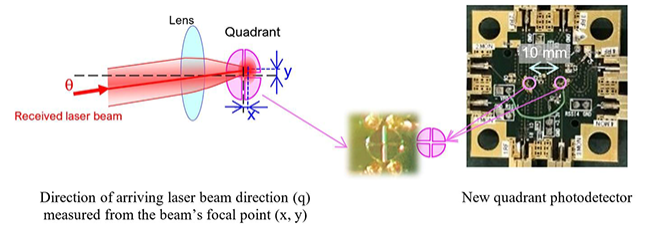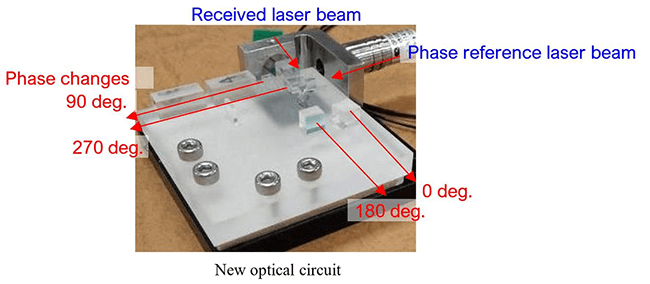Mitsubishi announces world’s first satellite laser terminal
07-06-2022 | By Robin Mitchell
Recently, Mitsubishi announced the world’s first laser receiver designed for use with earth-satellite communication. What challenges does traditional satellite communication present, what did Mitsubishi develop, and could laser communication find applications on earth?
What challenges do traditional satellite communication technologies present?
Satellite communication has played a critical role in the past 50 years providing telecommunication services, activity monitoring, environmental tracking, and weather observations. But while satellite technology has come a long way thanks to modern developments, radio waves remain the sole means of communication.
Now, major improvements have been made in this field using various frequencies and establishing dedicated bands to reduce interference, while improvements in electronics allow for higher data rates, but the use of radio wave energy hasn’t changed. This is primary since radio waves are easy to transmit and receive, can easily penetrate the earth’s atmosphere, and their divergence allows for more general targeting requirements (i.e., the transceiver needs to be pointed in the general direction of the target within a few miles instead of a few centimetres).
But radio waves are not without their flaws, and modern satellite systems continue to be plagued with the downfalls of radio waves. Firstly, their relatively low frequency (compared to visible light lasers) reduces their bandwidth, making it challenging to form high-speed data links. This is especially problematic with imaging satellites that need to report back high-resolution data in real-time.
The second challenge with radio waves is their divergence. While wider radio beams can more easily hit their target, they also run the risk of interfering with other satellites and, as such, require their own unique frequency bands. This has the added effect of reducing the bandwidth and limiting the total number of satellites in any given area.
The third challenge is that radio communication systems generally require a large antenna and dish. Devices that receive only (such as GPS modules) do not require such apart us, but anything that needs to send data back to a satellite will require a dish. As such, radio communication systems can become bulky and difficult to integrate into smaller devices.
Mitsubishi announces world’s first laser communication terminal for satellites
Recognising the challenges faced by traditional radio communication systems used in satellites, Mitsubishi has recently announced the development of the world’s first laser communication terminal. Instead of satellites using radio waves, their new system uses infrared light in the 1.5µm band that is formed into a laser beam. The new beam has a narrow width of 1/1000 less than current radio systems, meaning it is significantly less likely to interfere with nearby systems that are not directly observing the laser beam.
However, using laser beams for long-range communication raises some significant challenges, the most obvious being intensity degradation. A laser beam is shown through the earth’s atmosphere quickly loses its intensity, making it difficult for a receiver to detect the incoming beam. Another serious disadvantage of laser beams is that their narrow divergence requires them to be pointed directly at the receiving satellite. Combine this fact with the fast-moving nature of satellites relative to the ground, and the result is a system that needs to track the satellite while keeping a small thin laser beam pointed at a receiver hundreds of miles away, all while achieving a targeting accuracy of less than a meter.
And yet, the researchers at Mitsubishi have demonstrated a terminal receiver that can do just this. The receiver is able to determine two main factors from the incoming beam; its phase shift and its direction. The incoming direction of the beam is determined with the use of a lens and a quadrant sensor that consists of four main sensing elements arranged in a circle. This allows a system to precisely recognise the incoming beam’s position and thus adjust its angle and position to best receive the incoming signal.

The additional use of multiple beam splitters and reference beam also allows for the device to detect four-phase changes of 0˚, 90˚, 180˚, and 270˚. The importance of detecting phase shift will enable data to be conveyed using phase shift instead of just intensity control. While intensity control is the simplest form of data communication, it can easily interfere with ambient light and changes in the atmosphere, but phase change is something that is virtually impossible to interfere with.
Overall, the new device is housed in a 10cm3 box that is believed to not only be the world’s first optical laser solution for satellites but also one of the smallest and lightest.

Could laser communication become practical for earth-based communication?
While researchers still have many obstacles to overcome when using lasers with satellites, the use of laser communication for terrestrial applications also raises eyebrows.
One such application that could highly benefit from laser communication is military operations. Modern radio systems incorporate encryption methods to ensure data integrity, but any security flaws can potentially lead to enemy forces gathering key intelligence. Additionally, enemy forces may also deploy radio jamming equipment that denies the use of radio waves, and such systems are incredibly hard to fight against.
But the use of a laser beam would provide military command posts with direct communication that would be immune to hacking and interference. The direct use of a beam means that anyone wanting to hack would have to stand in the way of the beam, and this is not an easy feat when considering that blocking the beam would be detected on both sides.
Furthermore, the beam cannot be interfered with like radio waves can, and any attacker wishing to disable the link would need to either direct an intense laser beam at the receiver, which would give away the position of the enemy or stand in-between the beam which would still give away the position of the enemy.
Laser beams could also be potentially used to link cellular towers placed in remote areas where fibre optic links are too challenging to install. Entire arrays of beams can be established in close proximity that would not interfere with each other, and the addition of each beam would further increase the bandwidth of the data link. Finally, the use of laser beams removed interference effects between cell networks, allowing for long-distance communication without large amounts of infrastructure being installed.
Laser communication presents exciting opportunities for both satellite and terrestrial communication. There are still many challenges yet to be solved, but the ability to create communication channels that don’t interfere with each other, can cross over, and have high bandwidths could open up entirely new applications.

